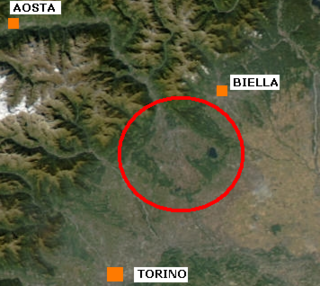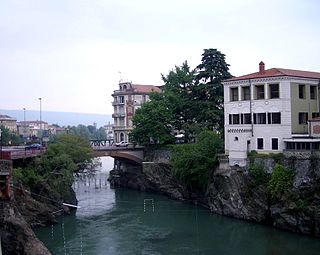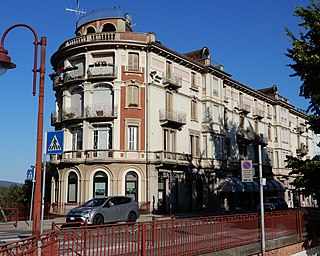
Aosta is the principal city of the Aosta Valley, a bilingual region in the Italian Alps, 110 km (68 mi) north-northwest of Turin. It is situated near the Italian entrance of the Mont Blanc Tunnel and the Great St Bernard Tunnel, at the confluence of the Buthier and the Dora Baltea, and at the junction of the Great and Little St Bernard Pass routes.

Ivrea is a town and comune of the Metropolitan City of Turin in the Piedmont region of northwestern Italy. Situated on the road leading to the Aosta Valley, it straddles the Dora Baltea and is regarded as the centre of the Canavese area. Ivrea lies in a basin that in prehistoric times formed a large lake. Today, five smaller lakes—Sirio, San Michele, Pistono, Nero and Campagna—are found in the area around the town.

Doire was a department of the French First Republic and of the First French Empire in present-day Italy. It was named after the river Dora Baltea. It was formed in 1802, when the Subalpine Republic was directly annexed to France. Its capital was Ivrea.

Dora Baltea or Doire Baltée is a river in northwestern Italy. It is a left-hand tributary of the Po and is about 170 kilometres (110 mi) long.

Ayas is a comune sparso in the Aosta Valley region of northwestern Italy, with 1359 inhabitants in 2010.

Bard is a town and comune in the Aosta Valley region of northwestern Italy. It is part of the Unité des communes valdôtaines du Mont-Rose and has a population of 134. It is one of I Borghi più belli d'Italia.

Émarèse is a town and comune in the Aosta Valley region of north-western Italy. It has 213 inhabitants.

Cirié is a comune (municipality) in the Metropolitan City of Turin in the Italian region Piedmont, located about 20 kilometres (12 mi) northwest of Turin.

Solutor, along with Octavius and Adventor, is patron saint of Turin.
The Salassi or Salasses were a Gallic or Ligurian tribe dwelling in the upper valley of the Dora Baltea river, near present-day Aosta, Aosta Valley, during the Iron Age and the Roman period.

The Buthier is a mountain torrent in north-west Italy. A left bank tributary of the Dora Baltea, its entire course lies within the Valpelline, a valley in the region of Aosta Valley.

The Chiusella valley is a valley in the Province of Turin.

Sarriod de la Tour Castle is a castle in the town of Saint-Pierre by the Dora Baltea River, in Northwestern Italy's Aosta Valley. The original castle was typical of the style built between the 10th and 12th centuries, and was greatly expanded by Jean Sarriod in 1420 and his son, Antoine, in 1478. The north wing's ground floor features a wooden-ceilinged "Hall of Heads", named for its decorative motifs.

Châtel-Argent was an Italian medieval castle in the Alpine town of Villeneuve. It is now a ruin. As with many other castles in the region, Châtel-Argent overlooks the Dora Baltea River which runs through the Aosta Valley.

The Ivrea Morainic Amphitheatre is a moraine relief of glacial origin located in the Canavese region. Administratively, it encompasses the metropolitan city of Turin and, more marginally, the province of Biella and the province of Vercelli. It dates back to the Quaternary period and was created by the transport of sediment to the Po Valley that took place during the glaciations by the great glacier that ran through the Dora Baltea valley. With an area of more than 500 km2, it is one of the best-preserved geomorphological units of this type in the world. As an extension, it is surpassed in Italy only by the similar formation surrounding Lake Garda. The name amphitheater, usually given to these geomorphological structures, refers to their characteristic elliptical shape that is noticeable when it is shown as a plan on a map.

The Ponte Nuovo is an arch bridge over the Dora Baltea in Ivrea, Italy.

Villa Luisa is a historic villa located in Ivrea, Italy.

Palazzo Ravera is a historic Art Nouveau building located in Ivrea, Italy.

Villa Chiampo is a historic villa located in Ivrea, Italy.

The Ivrea Railway Bridge is a truss railway bridge over the Dora Baltea in Ivrea, Italy.




















